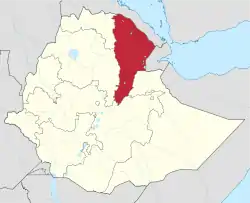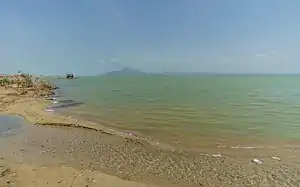Afar Region
Afar Region (/ˈɑːfɑːr/;[4] Afar: Qafar; Amharic: ዓፋር ክልል), formerly known as Region 2, is a regional state in Northeastern Ethiopia and the homeland of the Afar people. Its capital is the planned city of Semera, which lies on the paved Awash–Assab highway.

Afar Region
ዓፋር Qafár Rakaakayih Doolata | |
|---|---|
 Flag  Seal | |
 Map of Ethiopia showing Afar Region | |
| Country | Ethiopia |
| Capital | Semera |
| Area | |
| • Total | 72,053 km2 (27,820 sq mi) |
| [1] | |
| Population (2017) | |
| • Total | 1,812,002[2] |
| ISO 3166 code | ET-AF |
| HDI (2017) | 0.405[3] low · 11th |
The Afar Triangle, the northern part of which is the Danakil Depression, is part of the Great Rift Valley of Ethiopia, and is located in the north of the region. It has the lowest point in Ethiopia and one of the lowest in Africa. The southern part of the region consists of the valley of the Awash River, which empties into a string of lakes along the Ethiopian-Djibouti border. Other notable landmarks include the Awash and Yangudi Rassa National Parks.
Demographics
Based on the 2017 projections by the Central Statistical Agency of Ethiopia (CSA), the Afar Regional State has a population of 1,812,002, consisting of 991,000 men and 821,002 women; urban inhabitants number 346,000 of the population, a further 1,466,000 were pastoralists.[2]
Based on the 2007 Census conducted by the Central Statistical Agency of Ethiopia (CSA), the Afar Regional State has a population of 1,390,273,[5] consisting of 775,117 men and 615,156 women; urban inhabitants number 185,135 or 13.32% of the population, a further 409,123 or 29.43% were pastoralists. With an estimated area of 96,707 square kilometers, this region has an estimated density of 14.38 people per square kilometer. For the entire region 247,255 households were counted, which results in an average for the Region of 5.6 persons to a household, with urban households having on average 4 and rural households 6 people.
| Ethnic Group | 2007 Census[6] | 1994 Census[7] |
|---|---|---|
| Afar | 90.03% | 91.8% |
| Oromo | 5.22% | 4.5% |
| Argobba | 1.55% | 0.9% |
| Tigrayan | 1.15% | 0.8% |
| Amhara | 0.61% | 0.8% |
| Welayta | 0.59% | 0.5% |
| Hadiya | 0.18% | 0.2% |
| Religion | 2007 Census[6] | 1994 Census[7] |
|---|---|---|
| Muslim | 96 | 95.6% |
| Christian | 4.7% | 4.4% |
| Orthodox | 3.86% | 3.9% |
| P'ent'ay | 0.43% | 0.4% |
| Catholics | 0.09% | 0.1% |
In the previous census, conducted in 1994, the region's population was reported to be 1,106,383 of whom 626,839 were men and 479,544 women; urban inhabitants were 85,879 or 7.76% of the population.
Afar is predominantly (89.96%) spoken in the region and is the working language of the state. Other languages with a significant number of speakers in the state include Amharic (6.83%), Tigrinnya (1.06%), Argobba (0.79%), Wolaitigna (0.43%), and Oromifa (0.4%).
According to the CSA, as of 2004, 48.57% of the total population had access to safe drinking water, of whom 26.89% were rural inhabitants and 78.11% were urban.[8] Values for other reported common indicators of the standard of living for the Afar Regional State as of 2005 include the following: 67.3% of the inhabitants fall into the lowest wealth quintile; adult literacy for men is 27% and for women 15.6%; and the Regional infant mortality rate is 61 infant deaths per 1,000 live births, which is less than the nationwide average of 77; at least half of these deaths occurred in the infants’ first month of life.[9] On 20 April 2007, the Regional government announced that it had increased health coverage from 34% to 40%, the result of construction of 64 new health clinics, increasing the total for the Region to 111.[10]
Land features

Afar Depression, Erta Ale active volcano, Awash National Park, Yangudi Rassa National Park, Hadar and Aramis areas, are the major tourist attraction area of the region. The hot springs, Afar culture and cultural games are other attraction areas.
In 2005, a giant rift was formed in just a few days.[11][12] The rift opened when the Dabbahu Volcano, situated in the north of the region, erupted. The crack forming is thought to be part of the process in which the Arabian Plate and the two African plates, the Nubian Plate and the Somali Plate, are moving apart. This new crack, 500 metres (1,640 ft) long, and 60 metres (197 ft) deep, opened when the lava from the erupting volcano flowed underground and cooled forming a 60 kilometres (37 mi) long, 8 metres (26 ft) wide dike within days.
Environment
The Afar Depression, a plate tectonic triple junction is found in the Afar Regional State. This geologic feature is one of earth's great active volcanic areas. Due to this volcanic activity the floor of the depression is composed of lava, mostly basalt. The continuous process of volcanism results in the occurrence of major minerals including potash, sulfur, salt, bentonite, and gypsum. In addition to these minerals, there are also promising geothermal energy sources and hot springs in different areas of the region. Most of the region's mineral potential are found in Dallol, Berhale and Afxera woredas of Zone Two. Elidar, Dubti and Millee in Zone one and Gewane in Zone Three also have some mineral possibilities.

Afar is home to peculiar wild life, which notably include the African wild ass, Grevy's zebra, wild fox, wild cat, cheetah, and ostrich. These wild animals are found in the region's national parks. Because the region's tourism development is still in a poor state there are only two lodges in Awash National Park.
Agriculture
The CSA estimated in 2005 that farmers in the Afar Regional State had a total of 327,370 cattle (representing 0.84% of Ethiopia's total cattle), 196,390 sheep (1.13%), 483,780 goats (3.73%), 200 mules (0.14%), 12,270 asses (0.49%), 99,830 camels (21.85%), 38,320 poultry of all species (0.12%), and 810 beehives (less than 0.1%). The CSA estimated on the basis of a survey performed in December 2003 that nomadic inhabitants had 1,990,850 cattle (an 83.8% share of those animals in the Region that year), 2,303,250 sheep (90.6%), 3,960,510 goats (90%), 759,750 camels (85.9%), 175,180 asses (92.5%), 2960 mules (88.6%), and 900 horses (100%).[13]
Regional instability
As of 2012, the area has been increasingly unstable, as tensions between Ethiopia and Eritrea remain high after the Eritrean-Ethiopian War of 1998-2000. On January 18, 2012 five foreign tourists were murdered while on holiday in the region.[14] The Ethiopian government has accused Eritrean gunmen of being responsible for the attack. Many governments around the world advise against traveling to the Afar Region, citing increasing security concerns.
Fossil finds
Hadar, a community in Afar, was the site of the discovery in 1973-74 of "Lucy", the Australopithecus afarensis skeletal remains, by Donald Johanson of the Cleveland Museum of Natural History. On March 5, 2005, another skeleton, estimated to be 3.8 million years old and said to be the world's oldest bipedal hominid skeleton, was found in the region. Yohannes Haile-Selassie led digs there each year from 2004 to 2007.
.jpg.webp)
On March 24, 2006 it was reported that a "significantly complete" cranium had been found at Gawis in the Gona area.[15] The cranium appears as an intermediate form between Homo erectus and Homo sapiens.
On October 1, 2009, scientists reported that they had found a skeleton, which dates around 4.4 million years ago. Named Ardi, it is a form of the species Ardipithecus ramidus. The specimen is a distant cousin of the Australopithecus afarensis, Lucy's species.
In June 2010, the oldest direct evidence of stone tool manufacture was found in the Afar region and attributed to Australopithecus afarensis.[16][17]
In 2013, a graduate student from the Arizona State University discovered a hominid jawbone in the Ledi-Geraru region of Afar. Scientists estimated that the fossil dates back around 2.8 million years ago, which is 400,000 years before the next oldest hominid fossil remains.[18]
In 2015, a hominin jawbone and teeth was discovered in the Afar region. Scientists believe that the bones belonged to a previously undiscovered ancestor. The new species was named "Australopithecus deyiremeda", meaning "close relative" in the native Afar language. The species lived around 3.5 - 3.3 million years ago, about the same time period as other hominins such as Australopithecus afarensis.[19]
Presidents of the Executive Committee
- Habib Alimirah (ALF) 1992? - 1995
- Hanfare Alimirah (ALF) September 1995 - Mar 1996
- Ismaqil Qali Siro (APDO/ANDP) March 1996–September 2015
- Awol Arba Unde (acting) September 2015 - November 2015
- Seyoum Awol (ANDP) 16 November 2015 - 16 December 2018
- Awol Arba Unde (ANDP) 17 December 2018 – present
(This list is based on information from Worldstatesmen.org.)
Administrative zones
Like other regions in Ethiopia, Afar is subdivided into administrative zones (and one special woreda, an administrative subdivision which is an autonomous area and is not part of a zone).
- Administrative Zone 1: Awsi Rasu
- Administrative Zone 2: Kilbet Rasu
- Administrative Zone 3: Gabi Rasu
- Administrative Zone 4: Fanti Rasu
- Administrative Zone 5: Hari Rasu
- Argobba special woreda
Notes and references
- 2011 National Statistics Archived March 30, 2013, at the Wayback Machine
- Population Projection of Ethiopia for All Regions At Wereda Level from 2014 – 2017. Federal Democratic Republic of Ethiopia Central Statistical Agency. Archived from the original on 6 June 2018. Retrieved 4 June 2018.
- "Sub-national HDI - Area Database - Global Data Lab". hdi.globaldatalab.org. Retrieved 2018-09-13.
- "Afar". Dictionary.com Unabridged. Random House. Retrieved 6 February 2020.
- In Affar Region eight rural kebeles in Elidar Wereda, bordering Eritrea was not covered by census. To get the total population size of Affar region, you should add the estimated population size (21,410) of eight rural kebeles of Elidar wereda.
- " Census 2007 Tables: Afar Region" Archived November 13, 2012, at the Wayback Machine, Tables 2.1, 2.5, 3.1, 3.2, 3.4
- 1994 Population and Housing Census of Ethiopia Results for Affar Region: Vol. 2 Analytical Report Archived January 5, 2009, at the Wayback Machine Tables 2.13, 2.18 (accessed 29 December 2008) The 1994 national census was collected in the Afar Region on 22 July 1996.
- "Households by sources of drinking water, safe water sources" Archived March 5, 2009, at the Wayback Machine CSA Selected Basic Welfare Indicators (accessed 21 January 2009)
- Macro International Inc. "2008. Ethiopia Atlas of Key Demographic and Health Indicators, 2005." (Calverton: Macro International, 2008), pp. 2, 3, 10 (accessed 28 January 2009)
- "Health coverage reaches 40 percent in Afar State" (Walta Information Center)
- Giant Crack In Africa, New Scientist, November 4, 2009
- Newscientist.com
- 2003 is the latest year available for statistics on nomadic inhabitants. "CSA 2005 National Statistics" Archived November 18, 2008, at the Wayback Machine, Tables D.4 - D.7.
- "Tourists die in Ethiopia attack". BBC News. 2012-01-18.
- Stone Age Institute, Press Release on a New Hominid Cranium from Gona, Afar, Ethiopia Archived April 23, 2006, at the Wayback Machine, released March 24, 2006
- McPherron, Shannon P.; Alemseged, Zeresenay; Marean, Curtis W.; Wynn, Jonathan G.; Reed, Denné; Geraads, Denis; Bobe, René; Béarat, Hamdallah A. (2010). "Evidence for stone-tool-assisted consumption of animal tissues before 3.39 million years ago at Dikika, Ethiopia". Nature. 466 (7308): 857–860. Bibcode:2010Natur.466..857M. doi:10.1038/nature09248. PMID 20703305.
- Der Tagesspiegel 11.08.2010 - Urmenschen: Die ersten Schlachter
- "Student finds 2.8 million-year-old human genus jawbone in Ethiopia".
- Morelle, Rebecca (2015-05-28). "'New species' of ancient human found". BBC News.
External links
| Wikivoyage has a travel guide for Afar. |